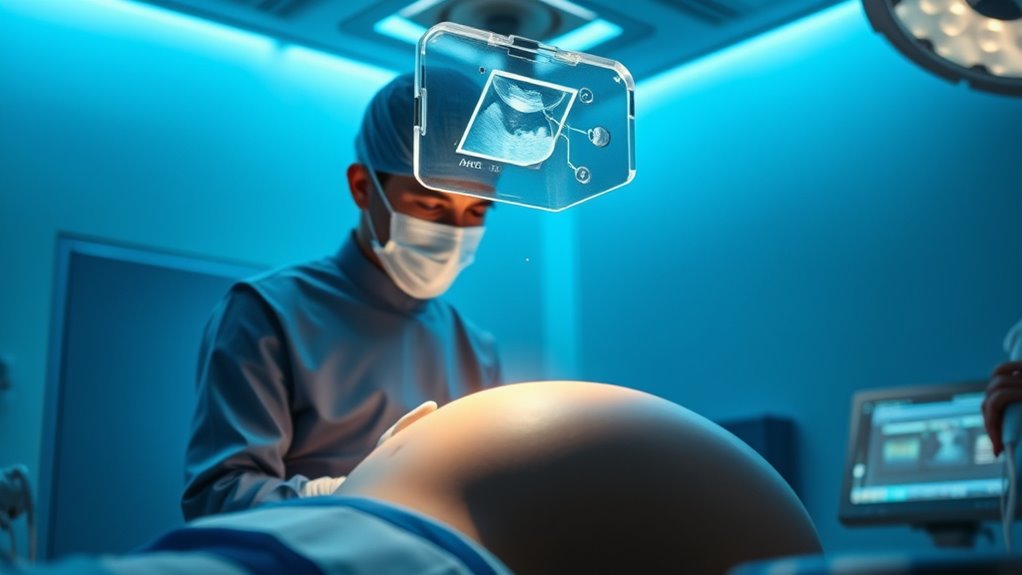Focused ultrasound technology allows you to undergo surgeries without a traditional scalpel, using high-frequency sound waves to target deep tissues precisely. It reduces blood loss, minimizes incisions, and often doesn’t require general anesthesia, leading to faster recovery. This innovative approach is used for conditions like tumors, movement disorders, and fibroids, providing safer, bloodless alternatives to conventional surgery. To discover how this breakthrough is changing healthcare, keep exploring the remarkable potential of ultrasound-guided treatments.
Key Takeaways
- Focused ultrasound uses high-frequency sound waves to target and destroy tissue precisely without incisions.
- It provides a bloodless, minimally invasive alternative to traditional scalpel-based surgery.
- Real-time imaging guides ultrasound treatment, reducing bleeding and risk of injury during procedures.
- Suitable for conditions like tumors, fibroids, and neurological disorders, eliminating the need for blood transfusions.
- Advancements in technology are making ultrasound-guided, bloodless surgeries safer, faster, and more accessible.
Understanding Focused Ultrasound Technology

Focused ultrasound technology uses high-frequency sound waves to target specific tissues deep within the body without making any incisions. This advances ultrasound therapy by enabling precise treatment of conditions traditionally requiring surgery. Unlike conventional surgical methods, focused ultrasound can destroy or alter tissue without cutting through skin or muscle. This innovative approach is part of recent surgical innovations aimed at reducing trauma, bleeding, and recovery time. You benefit from a minimally invasive procedure that’s often performed on an outpatient basis. The technology concentrates sound waves on a specific target, generating heat or mechanical effects to treat abnormalities. Additionally, the use of Kia Tuning techniques in medical devices is being explored to optimize performance and precision. As a result, focused ultrasound offers a safer, less invasive alternative for patients, pushing the boundaries of traditional surgery and opening new possibilities in medical treatment.
How Focused Ultrasound Works in Medical Procedures

Focused ultrasound delivers precise energy to targeted tissues without making any incisions. This non-invasive treatment approach minimizes risks and speeds up recovery. You can see how this technology transforms medical procedures by providing effective, bloodless solutions. Additionally, advancements in medical services are enhancing the accuracy and safety of these procedures.
Precise Energy Delivery
When performing minimally invasive procedures, precisely delivering energy to targeted tissues is essential, and focused ultrasound makes this possible. Using advanced ultrasound imaging, you can visualize the exact location of the tissue you want to treat, guaranteeing accurate targeting. Focused ultrasound employs energy modulation to concentrate acoustic energy precisely where needed, creating a controlled thermal or mechanical effect. This precise energy delivery allows you to ablate or modify tissue without damaging surrounding areas. Because the energy is focused, you can operate with high accuracy, reducing risks and improving outcomes. The combination of real-time imaging and sophisticated energy modulation techniques ensures you can perform procedures with remarkable precision, making bloodless surgery safer and more effective. Additionally, understanding signs of spoilage in materials used or involved in procedures can help ensure safety and effectiveness.
Non-Invasive Treatment Method
Focused ultrasound offers a non-invasive way to treat medical conditions without surgical incisions, harnessing sound waves to target tissues deep within the body. This technology has evolved from early experimental methods to advanced, real-time imaging-guided procedures. Its historical evolution reflects a shift toward safer, less invasive options, reducing risks and recovery time. Ethical considerations now focus on patient safety, informed consent, and accessibility. You can see how this method minimizes trauma and blood loss, making it suitable for high-risk patients. Continuous innovation in this field continues to improve precision and safety in treatments.
Benefits of Bloodless Surgery With Ultrasound

Ultrasound technology offers a significant advantage in bloodless surgery by enabling precise visualization of tissues and blood vessels in real-time. With ultrasound imaging, you can target problematic areas accurately, reducing the need for invasive procedures and minimizing blood loss. This real-time guidance helps avoid accidental injury to blood vessels, decreasing the likelihood of complications. Because blood transfusions are often necessary in traditional surgeries to replace lost blood, avoiding or reducing bleeding makes procedures safer and less risky. Additionally, ultrasound-guided bloodless surgery shortens recovery times and lowers infection risks. Proper juice extraction techniques can further enhance the clarity of ultrasound images by reducing artifacts, improving surgical precision. Overall, this technology enhances safety, improves outcomes, and offers a less invasive alternative for patients who prefer or need to avoid blood transfusions.
Conditions Treated Using Focused Ultrasound

Focused ultrasound has become an effective non-invasive treatment option for a variety of medical conditions. It leverages ultrasound imaging to precisely target tissues without incisions, reducing risks and recovery times. You can treat conditions such as tumors, essential tremors, and uterine fibroids with this technology. Focused ultrasound also offers promise for neurological disorders, including Parkinson’s disease, by targeting specific brain regions. Surgeons utilize advanced ultrasound imaging to guide procedures accurately, often requiring specialized surgical training to optimize outcomes.
Focused ultrasound offers a safe, precise, non-invasive way to treat tumors, tremors, and neurological disorders.
Some conditions treated include:
- Brain tumors and movement disorders
- Uterine fibroids
- Prostate cancer
- Bone metastases
- Essential tremors
Comparing Focused Ultrasound to Traditional Surgery

How does focused ultrasound compare to traditional surgery regarding safety, effectiveness, and recovery? Focused ultrasound offers a less invasive alternative, reducing risks like infection and bleeding. Unlike traditional surgery, it doesn’t require incisions or anesthesia, which shortens recovery time. Robotic assistance can enhance precision during ultrasound procedures, ensuring targeted treatment. Patient preparation is simpler; you often just need to follow specific instructions beforehand, avoiding lengthy prep or hospitalization. While traditional surgery may be necessary for complex cases, ultrasound-based treatments excel in reducing trauma and speeding up healing. Overall, focused ultrasound provides a safer, effective option with quicker recovery, making it an attractive choice for many patients seeking bloodless procedures without the risks associated with open surgery. Glycolic acid can be used post-treatment to help improve skin texture and support healing.
The Safety and Precision of Ultrasound-Based Treatments

Ultrasound-based treatments offer a safer alternative by reducing many risk factors associated with traditional surgery. You can expect highly targeted therapy that guarantees precise treatment while minimizing damage to surrounding tissues. Plus, because the procedure is non-invasive, it often results in quicker recovery and fewer complications. These advancements are part of the broader movement toward less invasive medical procedures that prioritize patient safety and comfort.
Minimized Risk Factors
Because these treatments rely on precise imaging and targeted energy delivery, they markedly reduce the risk of complications compared to traditional surgery. You benefit from fewer infections, less bleeding, and minimized damage to surrounding tissues. This makes ultrasound-based procedures ideal for cosmetic enhancements, where precision is vital, and for veterinary applications, reducing stress on animals. Additionally, the non-invasive nature lowers anesthesia-related risks. You also avoid scars and prolonged recovery times. Research companies thoroughly before investing to ensure the safety and reliability of the procedures used.
Targeted Therapeutic Accuracy
Targeted therapeutic accuracy is a key advantage of ultrasound-based treatments, allowing you to precisely focus energy on affected tissues while sparing healthy surroundings. Ultrasound imaging plays an essential role in this process, providing real-time visualization to guide treatment with exceptional detail. Focused ultrasound diagnostics enable practitioners to pinpoint exact treatment areas, reducing the risk of damage to nearby structures. The accuracy ensures that energy is concentrated solely where needed, enhancing safety and effectiveness. This precision minimizes unintended effects and contributes to better patient outcomes. By combining advanced imaging with focused ultrasound technology, practitioners can deliver targeted therapy confidently, transforming how conditions are treated without invasive procedures or blood loss. Additionally, ongoing advancements in AI integration are further improving the precision and safety of ultrasound-guided therapies.
Non-Invasive Procedure
Non-invasive procedures using ultrasound technology offer a safe and precise alternative to traditional surgery. You avoid risks associated with surgical instruments and blood donation, reducing complications and recovery time. Ultrasound-based treatments target specific tissues without incisions, minimizing trauma and blood loss. This method is especially beneficial for patients who can’t tolerate blood donation or prefer to avoid scalpel-based procedures. Additionally, the use of high-resolution imaging improves color accuracy and treatment precision during procedures.
Patient Experiences and Recovery Stories

Many patients who undergo bloodless surgery report a smoother recovery process and less postoperative discomfort compared to traditional procedures. You’ll likely find that patient testimonials highlight quicker healing and fewer complications, making the overall experience more manageable. Recovery experiences tend to involve less pain, minimal scarring, and a faster return to normal activities. With focused ultrasound, you might notice reduced hospital stays and a lower risk of infection, which contributes to a more positive outlook post-surgery. Patients often share how this approach allows them to avoid blood transfusions and their associated risks, giving peace of mind. Overall, these stories reflect high satisfaction, emphasizing how bloodless surgery can improve your recovery journey and quality of life.
Future Developments in Ultrasound Surgical Techniques

Advancements in ultrasound technology are poised to revolutionize surgical procedures, making them safer and more effective. Future developments will enhance ultrasound imaging, enabling real-time, high-resolution views of target tissues, which improves surgical planning. You’ll see more precise targeting of abnormal tissues, reducing collateral damage. Additionally, integration with AI algorithms will assist in predicting tissue response and guiding procedures. Innovations may include portable, handheld devices for quick diagnostics and treatment in outpatient settings. Furthermore, 3D and 4D ultrasound imaging will facilitate detailed visualization of complex structures. These improvements will streamline procedures, reduce operation times, and minimize risks. As ultrasound techniques evolve, your surgical options will expand, offering safer, less invasive solutions with better outcomes.
- Enhanced resolution for clearer images
- Real-time 3D/4D visualization
- AI-powered surgical guidance
- Portable devices for accessibility
- Improved precision in targeting tissues
Challenges and Limitations of Focused Ultrasound

Focused ultrasound faces challenges like ensuring precision and safety, which can be difficult in complex cases. Its treatment options are limited to specific conditions, restricting widespread use. Additionally, high costs and limited access can prevent many patients from benefitting from this technology.
Precision and Safety Concerns
While focused ultrasound offers promising precision in targeting tissues, safety concerns remain a significant hurdle. You must consider risks like unintended tissue damage and radiation exposure, which could affect patient safety. The success of the procedure heavily depends on surgeon expertise, as miscalculations can lead to complications. Additionally, factors such as tissue variability and movement can compromise accuracy. Here are key safety considerations:
- Accurate targeting to prevent collateral damage
- Managing radiation exposure for both patient and staff
- Ensuring surgeon proficiency with technology
- Monitoring tissue response during treatment
- Addressing limitations in imaging guidance
Overcoming these concerns requires rigorous training and precise control, underscoring that while ultrasound is promising, safety remains paramount.
Limited Treatment Applications
Despite its promise, focused ultrasound currently faces significant limitations that restrict its widespread use. It’s primarily effective for specific treatments like tumor ablation and neurological conditions, but its scope is still limited. For cosmetic enhancements, the technology isn’t yet refined enough for broad application, often requiring precise targeting that’s difficult in some cases. Veterinary applications also remain niche, as the equipment and expertise needed are not widely available for animal treatments. Additionally, the depth and size of target tissues can hinder effectiveness, especially in larger or more complex cases. These limitations mean focused ultrasound isn’t a universal solution yet; its use remains confined to select procedures and patient groups while ongoing research aims to expand its treatment repertoire.
Cost and Accessibility
Have you ever wondered why focused ultrasound isn’t more widely available? The main barriers are cost and regional availability. This technology requires expensive equipment and specialized training, limiting its use to certain centers. Insurance coverage is inconsistent, making it a challenge for many patients to afford treatment. Additionally, regional disparities restrict access, especially in rural or underserved areas. Factors affecting accessibility include:
- High equipment costs
- Limited number of trained specialists
- Insurance reimbursement issues
- Concentration in urban centers
- Slow integration into healthcare systems
These hurdles slow the widespread adoption of focused ultrasound, despite its potential benefits. Overcoming these challenges requires policy changes, increased funding, and broader training efforts to make this bloodless procedure more accessible to all patients.
The Impact on Healthcare and Surgical Practices

Bloodless surgery has profoundly transformed healthcare and surgical practices by reducing reliance on blood transfusions, which historically carried risks such as infections and immune reactions. Ultrasound innovations enable minimally invasive procedures that often require less anesthesia and shorten recovery times. As a result, hospitals can improve patient outcomes and reduce complications. These advancements also influence surgical training, emphasizing new techniques that focus on ultrasound-guided procedures instead of traditional scalpel-based methods. Surgeons need to adapt their skills to these evolving tools, making training more dynamic and technology-driven. Overall, the shift toward ultrasound-based, bloodless techniques pushes healthcare systems to become safer, more efficient, and more accessible, ultimately benefiting both providers and patients through better safety profiles and expanded treatment options.
Frequently Asked Questions
Are There Any Long-Term Risks Associated With Focused Ultrasound Procedures?
You wonder about long-term risks associated with focused ultrasound procedures. While these treatments are generally safe, there’s limited data on long-term effects, making risk assessment challenging. You might experience minor side effects initially, but potential long-term effects could include tissue changes or nerve damage. Consulting with your healthcare provider helps you understand the risks and benefits, ensuring you make an informed decision based on current evidence and your personal health situation.
What Types of Medical Facilities Are Equipped to Perform Ultrasound Surgeries?
Did you know that only about 15% of hospitals worldwide have the specialized equipment needed for ultrasound surgeries? These procedures require advanced technology and surgical expertise, so you’ll find them mainly in large, specialized medical centers or academic hospitals. Such facilities are equipped with the necessary tools and trained professionals to perform safe, effective ultrasound surgeries, making access somewhat limited but expanding as technology advances.
How Does Patient Selection Impact the Success of Ultrasound-Based Treatments?
You should understand that patient selection greatly influences the success of ultrasound-based treatments. By evaluating patient criteria and determining treatment suitability, healthcare providers ensure the procedure targets appropriate cases. If you meet the specific criteria, your chances of a successful outcome increase. Conversely, if you don’t fit the profile, the treatment might not be effective or safe. Proper evaluation is essential to maximize benefits and minimize risks.
Can Focused Ultrasound Procedures Be Repeated if Necessary?
You might worry about repeatability concerns with focused ultrasound procedures, but the good news is that many treatments can be repeated if necessary. Focused ultrasound is often safe for multiple sessions, especially when tailored to your specific condition. Treatment frequency varies based on your response, but doctors typically monitor progress closely, ensuring that follow-up procedures are effective and safe whenever you need them.
What Training Is Required for Medical Professionals to Perform Ultrasound Surgeries?
You need specialized training to perform ultrasound surgeries, focusing on mastering ultrasound technology and surgical precision. This involves completing medical education, then advancing through specific courses or certifications in ultrasound-guided procedures. Hands-on experience is vital, so you’ll learn how to operate equipment accurately and guarantee patient safety. With proper training, you gain the skills to use ultrasound technology effectively, making surgeries less invasive and more precise.
Conclusion
Imagine avoiding blood transfusions and quickening your recovery with focused ultrasound. For example, a patient with a benign brain tumor underwent ultrasound treatment, avoiding invasive surgery and blood loss. This breakthrough lets you experience less pain, fewer complications, and faster healing. As technology advances, more conditions could be treated non-invasively. Embrace the future of bloodless surgery—where ultrasound replaces the scalpel, transforming your surgical experience and improving outcomes worldwide.










